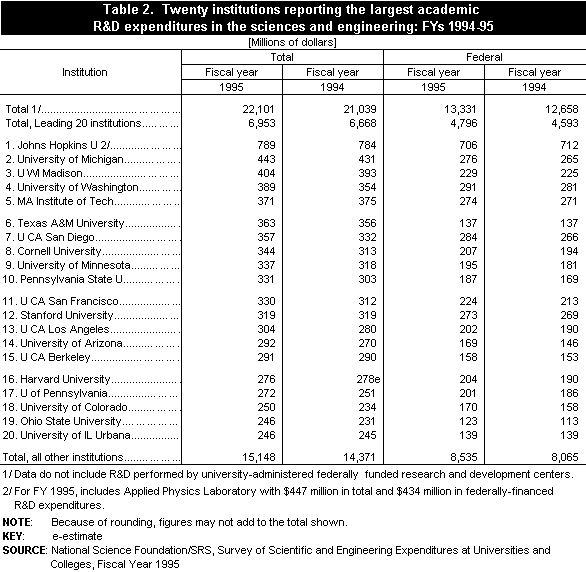By M. Marge
Machen
Sources of R&D Funding
Federally financed academic R&D spending increased 5 percent (3 percent in
constant dollars) in FY 1995, to $13 billion. For the third consecutive year,
the Federal Government provided 60 percent of the R&D dollars expended at
universities and colleges. Ten years earlier, the Federal share of the academic
R&D performance total was 63 percent (table 1).
The 5-percent increase in R&D expenditures from all non-Federal sources combined (3 percent in constant dollars) mirrored Federal and total gains, reaching $8.8 billion in FY 1995. Funds from State and local governments increased the fastest-6 percent in FY 1995, after little growth in 1994 (less than 1 percent). Institutional funds grew by nearly 6 percent, industry funding was up 5 percent, and funds from all other non-Federal sources (including private foundations and voluntary sources) rose 1 percent.
Total expenditures devoted to basic research at universities and colleges rose to $14.8 billion, a 5-percent increase over FY 1994, or a 3-percent gain after adjusting for inflation. The Federal Government provided $9.5 billion, for a 6-percent increase (4 percent in constant dollars). As a result, the Federal share of total basic research increased for the fourth consecutive year, from 61 percent in 1991 to 64 percent in 1995.
Applied research and development activities combined totaled $7.3 billion in 1995, up 5 percent over 1994 levels. The Federal Government provided 53 percent of the applied R&D total in 1995.
Fields of Research
Academic R&D spending in engineering increased 6 percent over 1994 levels
compared to a 5-percent gain for the sciences. All but mathematical sciences
grew faster than the 1.8-percent rate of inflation in major science and
engineering fields for which data were collected. Rates of growth range from a
high of 7 percent in the social sciences to a low of 1 percent in mathematical
sciences. Federally financed expenditures kept pace with inflation in 6 of the
8 major science and engineering fields (chart 1). Only Federal
funding increases for environmental and mathematical sciences fell below the rate of inflation.
Historically, R&D expenditures have been highly concentrated in relatively few institutions. The 100 leading research institutions accounted for 82 percent of Federally financed spending and 80 percent of all R&D dollars in FY 1995. The 20 leading research performers represented a 36-percent share of Federally sponsored expenditures and 31 percent of total academic R&D spending (table 2).


